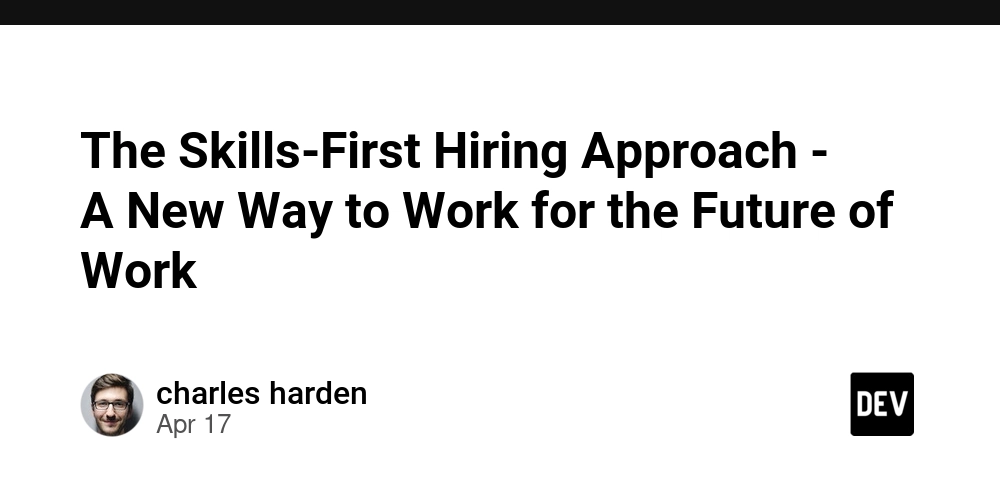The Skills-First Hiring Approach - A New Way to Work for the Future of Work
The traditional method of evaluating candidates — mainly on the basis of degrees, job titles, and years of experience - is no longer an adequate approach to hiring in today’s fast-moving job market. With industries changing more swiftly than ever before, many organizations are discovering that a prospective employee’s skills - not their credentials - are the best predictors of future success in a role. This is leading to the adoption of a skills-first approach to hiring, which is a paradigm shift that emphasizes competencies over credentials. Skills-First Approach A skills-first hiring mentality emphasizes evaluating talent based on the requisite skills and abilities that candidates can offer as opposed to traditional measures such as degrees, certifications, or previous job titles. Instead of asking, “Does this person have the right pedigree for this role?” the skills-first model says, “Does this person have the right skills to do the job well?” This approach acknowledges that: Experience does not equal proficiency: Someone can have been in a role for years, but that does not mean they know how to be effective in it. Skills are Found Anywhere: Self-learners, non-linear job-hoppers, and non-traditional candidates can be very valuable. Upskilling and Reskilling Matter: The pace of change in many industries means that the ability to learn, grow, and adapt can be more valuable than static qualifications. Reasons to Move to a Skills-First Model The reasons to adopt a skills-first hiring strategy are numerous and compelling. Here are some top reasons organizations are adopting this approach: 1. Expanded Talent Pool: Removing hard requirements like having a degree or a certain number of years in a field will allow organizations to access a broader, more diverse talent pool. This encompasses people with nontraditional educational backgrounds, people who are self-employed, and those recently returning to work after an absence. 2. Increased Diversity in the Workplace: Focusing on skills works to level the playing field for underrepresented groups that might not have access to traditional education pathways but have the skills needed to succeed. This helps create more diverse and innovative teams. 3. Faster Time-to-Hire: By training in more discrete skills and eliminating extraneous credential vetting, recruiters can also streamline the process since so much time is wasted looking over irrelevant qualifications. 4. Future-Proofing Your Workforce: A skills-first approach looks at what a candidate can do in the present and their capacity to develop. This matters in a world where job roles are constantly changing, and being able to upskill rapidly is a competitive differentiator. 5. Improved Job Performance: Hiring employees based on demonstrated competencies means they are more likely to succeed in their roles, as they already demonstrate the skills necessary to do the job. How to Implement a Skills-First Approach? Transitioning to a skills-first hiring model necessitates changes to mindsets, processes, and tools. Here are some actionable steps to bake this approach into your organization’s recruitment strategy: 1. Redefine Job Descriptions: Shift From Degrees to Skills. Replace requirements about degrees or certifications with the skills required and the outcomes expected from the role. Instead of asking for “a Bachelor’s degree in Marketing,” you should ask for “the ability to create and execute digital marketing campaigns.” Speak Their Language: Edit out vague phrases like “good communication skills.” Instead, say “ability to prepare compelling presentations for executive stakeholders.” 2. Utilize Skill-Based Evaluations: Use assessments, simulations, or project-based evaluations to see how candidates apply their skills in real-world contexts. For example: A technical challenge for a coder A case study talk for marketing professionals They provide a clearer indication of a candidate’s abilities than resumes and interviews by themselves. 3. Invest in Training & Accountability for Hiring Managers: Teach hiring managers that you can teach the skills and focus on skills, not credentials. Educate them on how to carry out behavioral and competency-based interviews to evaluate specific skills and problem-solving capabilities. 4. Utilize Technology and Data: ATS Interview tool with AI capabilities to filter candidates emphasize skills over degrees. Track the performance of skills-based hires using people analytics and iterate over time. 5. Emphasize Internal Mobility: Establish programs that allow current employees to transition to new positions based on skills rather than job titles or years in the company.Reskill and upskill programs for encouraging lateral career growth. 6. Partner with Nontraditional Talent Pipelines: Partner with boot camps and online learning platforms, as well as community organizations that offer alternative skills training opport

The traditional method of evaluating candidates — mainly on the basis of degrees, job titles, and years of experience - is no longer an adequate approach to hiring in today’s fast-moving job market. With industries changing more swiftly than ever before, many organizations are discovering that a prospective employee’s skills - not their credentials - are the best predictors of future success in a role. This is leading to the adoption of a skills-first approach to hiring, which is a paradigm shift that emphasizes competencies over credentials.
Skills-First Approach
A skills-first hiring mentality emphasizes evaluating talent based on the requisite skills and abilities that candidates can offer as opposed to traditional measures such as degrees, certifications, or previous job titles.
Instead of asking, “Does this person have the right pedigree for this role?” the skills-first model says, “Does this person have the right skills to do the job well?”
This approach acknowledges that:
Experience does not equal proficiency: Someone can have been in a role for years, but that does not mean they know how to be effective in it.
Skills are Found Anywhere: Self-learners, non-linear job-hoppers, and non-traditional candidates can be very valuable.
Upskilling and Reskilling Matter: The pace of change in many industries means that the ability to learn, grow, and adapt can be more valuable than static qualifications.
Reasons to Move to a Skills-First Model
The reasons to adopt a skills-first hiring strategy are numerous and compelling. Here are some top reasons organizations are adopting this approach:
1. Expanded Talent Pool: Removing hard requirements like having a degree or a certain number of years in a field will allow organizations to access a broader, more diverse talent pool. This encompasses people with nontraditional educational backgrounds, people who are self-employed, and those recently returning to work after an absence.
2. Increased Diversity in the Workplace: Focusing on skills works to level the playing field for underrepresented groups that might not have access to traditional education pathways but have the skills needed to succeed. This helps create more diverse and innovative teams.
3. Faster Time-to-Hire: By training in more discrete skills and eliminating extraneous credential vetting, recruiters can also streamline the process since so much time is wasted looking over irrelevant qualifications.
4. Future-Proofing Your Workforce: A skills-first approach looks at what a candidate can do in the present and their capacity to develop. This matters in a world where job roles are constantly changing, and being able to upskill rapidly is a competitive differentiator.
5. Improved Job Performance: Hiring employees based on demonstrated competencies means they are more likely to succeed in their roles, as they already demonstrate the skills necessary to do the job.
How to Implement a Skills-First Approach?
Transitioning to a skills-first hiring model necessitates changes to mindsets, processes, and tools. Here are some actionable steps to bake this approach into your organization’s recruitment strategy:
1. Redefine Job Descriptions: Shift From Degrees to Skills. Replace requirements about degrees or certifications with the skills required and the outcomes expected from the role. Instead of asking for “a Bachelor’s degree in Marketing,” you should ask for “the ability to create and execute digital marketing campaigns.” Speak Their Language: Edit out vague phrases like “good communication skills.” Instead, say “ability to prepare compelling presentations for executive stakeholders.”
2. Utilize Skill-Based Evaluations: Use assessments, simulations, or project-based evaluations to see how candidates apply their skills in real-world contexts. For example:
A technical challenge for a coder
A case study talk for marketing professionals
They provide a clearer indication of a candidate’s abilities than resumes and interviews by themselves.
3. Invest in Training & Accountability for Hiring Managers: Teach hiring managers that you can teach the skills and focus on skills, not credentials. Educate them on how to carry out behavioral and competency-based interviews to evaluate specific skills and problem-solving capabilities.
4. Utilize Technology and Data: ATS Interview tool with AI capabilities to filter candidates emphasize skills over degrees. Track the performance of skills-based hires using people analytics and iterate over time.
5. Emphasize Internal Mobility: Establish programs that allow current employees to transition to new positions based on skills rather than job titles or years in the company.Reskill and upskill programs for encouraging lateral career growth.
6. Partner with Nontraditional Talent Pipelines: Partner with boot camps and online learning platforms, as well as community organizations that offer alternative skills training opportunities.Develop apprenticeship or internship programs to attract candidates with potential but no formal experience.
The Difficulty of Skills-First Hiring (and How to Solve It)
Although the advantages of skills-first hiring are well-documented, this kind of planning has some challenges:
1. Changing Mindsets: Most hiring managers and recruiters are used to leaning on degrees and conventional credentials. Combating this bias needs to start from top support and ongoing education.
Solution: Keep it real and showcase successful skills-first hires in the org. Show data on how these hires do better than traditional hires.
2. Anticipating and Assessing Skills: Evaluating skills isn’t always straightforward and may be quite difficult for roles that call for soft skills such as leadership or flexibility.
Solution: Use validated assessments and standardized evaluation criteria. Use more than one assessment technique, including both technical tests and behavioral interviews.
3. Resistance to Change: It can be challenging to radically change long-established recruitment processes.
Solution: Run a pilot skills-first approach for certain roles or departments. Leverage findings to make a business case to scale the strategy enterprise-wide.
Real-Life Skills-First Hiring Examples
IBM’s Skills-First Approach
IBM has long been a leader in skills-first hiring. The company dropped degree requirements from almost half of its United States job listings above the entry-level, citing skills learned in a coding boot camp or on the job. This shift has enabled IBM to attract a more diverse group of talent and mitigate hiring biases.
Interviews at Google (Technical Focus)
Google changed the way it hired, swapping credentials, even formal experience, for hands-on technical assessments. Because candidates are evaluated based on what they can do, not where they come from, coding challenges and problem-solving exercises help showcase their skills and ensure the best candidates rise to the top.
Reskilling Programs at Walmart
Walmart offered upskilling programs to its workers, allowing them to pivot to higher-paying tech jobs within the organization. Focusing on skills rather than past titles has helped Walmart squeeze the most value out of its employee base while also filling its talent gaps.
Skills-First Thinking in the Future of Work
With industries evolving through new technologies and automation, the conventional routes to a job are becoming increasingly irrelevant. A hiring strategy rooted in skills not only meets the challenge of this ever-evolving landscape but ultimately sets organizations up for success by emphasizing adaptability, innovativeness, and varied perspectives.
Furthermore, the trend toward skills-first hiring reflects larger societal shifts, including the increased accessibility of online education tools and the need for more fair hiring practices. Adopting this model enables organizations to lead the way for the future of work.
Conclusion
Not just a trend, the skills-first approach to hiring is a necessity in our competitive and dynamic job market today. Emphasizing what candidates can do, not where they’ve been, allows organizations to tap into unrealized potential, spur innovation, and hire for a workforce positioned to meet the challenges of tomorrow.





























![[Webinar] AI Is Already Inside Your SaaS Stack — Learn How to Prevent the Next Silent Breach](https://blogger.googleusercontent.com/img/b/R29vZ2xl/AVvXsEiOWn65wd33dg2uO99NrtKbpYLfcepwOLidQDMls0HXKlA91k6HURluRA4WXgJRAZldEe1VReMQZyyYt1PgnoAn5JPpILsWlXIzmrBSs_TBoyPwO7hZrWouBg2-O3mdeoeSGY-l9_bsZB7vbpKjTSvG93zNytjxgTaMPqo9iq9Z5pGa05CJOs9uXpwHFT4/s1600/ai-cyber.jpg?#)










































































































































![[The AI Show Episode 144]: ChatGPT’s New Memory, Shopify CEO’s Leaked “AI First” Memo, Google Cloud Next Releases, o3 and o4-mini Coming Soon & Llama 4’s Rocky Launch](https://www.marketingaiinstitute.com/hubfs/ep%20144%20cover.png)





























































































































![[FREE EBOOKS] Machine Learning Hero, AI-Assisted Programming for Web and Machine Learning & Four More Best Selling Titles](https://www.javacodegeeks.com/wp-content/uploads/2012/12/jcg-logo.jpg)








































































![Rogue Company Elite tier list of best characters [April 2025]](https://media.pocketgamer.com/artwork/na-33136-1657102075/rogue-company-ios-android-tier-cover.jpg?#)








































































_Andreas_Prott_Alamy.jpg?width=1280&auto=webp&quality=80&disable=upscale#)






























































































![What’s new in Android’s April 2025 Google System Updates [U: 4/18]](https://i0.wp.com/9to5google.com/wp-content/uploads/sites/4/2025/01/google-play-services-3.jpg?resize=1200%2C628&quality=82&strip=all&ssl=1)










![Apple Watch Series 10 Back On Sale for $299! [Lowest Price Ever]](https://www.iclarified.com/images/news/96657/96657/96657-640.jpg)
![EU Postpones Apple App Store Fines Amid Tariff Negotiations [Report]](https://www.iclarified.com/images/news/97068/97068/97068-640.jpg)
![Apple Slips to Fifth in China's Smartphone Market with 9% Decline [Report]](https://www.iclarified.com/images/news/97065/97065/97065-640.jpg)


































































































































![[FR] Qu'est ce que le changement de cap d'Angular 15+ a apporter](https://media2.dev.to/dynamic/image/width=800%2Cheight=%2Cfit=scale-down%2Cgravity=auto%2Cformat=auto/https%3A%2F%2Fdev-to-uploads.s3.amazonaws.com%2Fuploads%2Farticles%2Fi0utarwalwobt11iuv7c.jpg)

